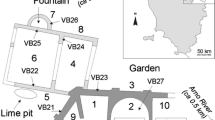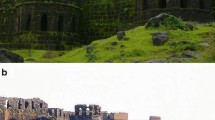Abstract
Historical mortars from sixteenth to seventeenth century military forts located at the mouth of the Tagus River in Lisbon have been characterized by polarized light microscopy (PLM), thermal analysis (TG/DTA), X-ray diffractometry (XRD) and scanning electron microscopy + energy dispersive spectroscopy (SEM + EDS). The results indicate that the mortars used were all hydraulic lime-based. The presence of well-rounded lime lumps indicates a limited use of water during the lime hydration process. The detection of hydrated calcium chloroaluminate and carboaluminate compounds mostly at binder-aggregate interfaces provides evidence for the onset of pozzolanic reactions during mortar production as further confirmed by the presence of ceramic fragments in the aggregate fractions intentionally added by the fort builders to increase the hydraulic properties of the mortars. The higher mechanical strength and greater resistance to degradation processes imparted by these pozzolanic compounds could explain why, despite the extreme proximity of the investigated sites to the sea, salt weathering processes do not appear to have significantly affected the studied mortars.








Similar content being viewed by others
References
Bakolas A, Biscontin G, Contardi V, Franceschi E, Moropoulou A, Palazzi D, Zendri E (1995) Thermoanalytical research on traditional mortars in Venice. Thermochim Acta 269(270):817–828
Bakolas A, Biscontin G, Moropoulou A, Zendri E (1998) Characterization of structural Byzantine mortars by thermogravimetric analysis. Thermochim Acta 321:151–160
Baronio G, Binda L (1997) Study of the pozzolanicity of some bricks and clays. Constr Build Mater 11:6–41
Baronio G, Binda L, Lombardini N (1997) The role of brick pebbles and dust in conglomerates based on hydrated lime and crushed bricks. Constr Build Mater 11:33–40
Callebaut K, Elsen J, Balen KV, Viaene W (2001) Nineteenth century hydraulic restoration mortars in the Saint Michael’s Church (Leuven, Belgium). Cement Concrete Comp 31:397–403
Candeias AE, Silva AS, Pais AC, Nogueira PM (2005) Caracterização de Argamassas do Conjunto Monumental do Castelo de Viana do Alentejo. Conservar Património, ARP nº 1: 21- 32. Conservação e Reabilitação de Edifícios, vol 2, pp 917–926, LNEC DMC, 11 p., LNEC
Elsen J (2006) Microscopy of ancient mortars—a review. Cem Concr Res 36:1416–1424
Elsen J, Brutsaert A, Deckers M, Brulet R (2004) Microscopical study of ancient mortars from Tournai (Belgium). Mater Charact 53:289–294
Jedrzejewska H (1960) Old mortars in Poland: a new method of investigation. Stud Conserv 4(5):132–138
Lindqvist JE, Sandström M (2000) Quantitative analysis of historical mortars using optical microscopy. Mater Struct 33:612–617
Maravelaki-Kalaitzaki P, Bakolas A, Moropoulou A (2003) Physico-chemical study of Cretan ancient mortars. Cem Concr Res 33:651–661
Middendorf B, Hughes JJ, Callebaut K, Baronio G, Papayianni I (2005a) Investigative methods for the characterisation of historic mortars—Part 1: mineralogical characterization. Mater Struct/Materiaux Constructions 38(282):761–769
Middendorf B, Hughes JJ, Callebaut K, Baronio G, Papayianni I (2005b) Investigative methods for the characterisation of historic mortars—Part 2: Chemical characterization. Mater Struct/Materiaux Constructions 38(282):771–780
Moral SS, Luque L, Cañaveras JC, Soler V, Guinea JG, Aparicio A (2004) Lime pozzolana mortars in Roman catacombs: composition, structures and restoration. Cem Concr Res 35(8):1555–1565
Moropolou A, Bakolas A, Bisbikou K (2000) Investigation of the technology of historic mortars. J Cult Her 1:45–48
Moropoulou A, Bakolas A, Bisbikou K (1995) Characterization of ancient, byzantine and later mortars by thermal and X-ray diffraction techniques. Thermochim Acta 269(270):779–795
Moropoulou A, Cakmak AS, Biscontin A, Bakolas A, Zendri E (2002) Advanced Byzantine cement-based composites resisting earthquake stresses: the crushed brick/lime mortars of Justinian’s Hagia Sophia. Constr Build Mater 16:543–552
Moropoulou A, Bakolas A, Anagnostopoulou S (2005) Composite materials in ancient structures. Cem Concr Comps 27:295–300
Reis MOB, Silva AS (1995) Caracterização de Argamassas do Aqueduto das Águas Livres. Relatório 292/95—NQ, 19 p, LNEC
Riccardi MP, Duminuco P, Tomasi C, Ferloni P (1998) Thermal Microscopy and X-ray studies on some ancient mortars. Thermochim Acta 321:207–214
RILEM Technical Committee (2004) Characterization of old mortars with respect to their repair” (TC 167-COM). In: Groot C, Ashall G, Hughes J (eds) Characterization of old mortars with respect to their repair—final report of RILEM TC 167-COM
RILEM Technical Committee (2009) Rilem TC 203-RHM:Repair mortars for historic masonry. Testing of hardened mortars, a process of questioning and interpreting. Mater Struct 42:853–865
Sabbioni C, Zappia G, Riontino C, Varela MTB, Aguilera FP, Balen KV, Toumbakari EE (2001) Atmospheric deterioration of ancient and modern hydraulic mortars. Atmos Environ 35:539–548
Sabbioni C, Bonazza A, Zappia G (2002) Damage on hydraulic mortars: the Venice Arsenal. J Cult Her 3:83–88
Schiavon N, Mazzocchin GA (2009) The provenance of sand in mortars from Roman Villas in Ne Italy: a chemical-mineralogical approach. Open Mineral 3:32–39
Schiavon N, Mazzocchin GA, Baudo F (2008) Chemical and mineralogical characterisation of weathered historical bricks from the Venice lagoonal environment. Environ Geol 56:767–775
Schouenborg B, Lindqvist JE, Sandstrom H, Sandstrom M, Sandin K, Sidmar E (1993) Analysis of old lime plaster and mortar from southern Sweden. Swedish National Testing and Research Institute, SP Report 34
Silva AS (2002) Caracterização de Argamassas Antigas – Casos Paradigmáticos. Cadernos de Edifícios 2, Revestimentos de paredes em edifícios antigos, LNEC, pp 87–101
Silva AS (2003) Nova Abordagem na Caracterização de Argamassas Antigas. 3º ENCORE—Encontro sobre Conservação e Reabilitação de Edifícios, LNEC, pp 917–926
Silva AS, Reis MOB (1999) Caracterização de Argamassas do Forte do Bugio-Lisboa. Nota Técnica nº 80/99—DMC
Silva AS, Veiga MR (2008) “Degradation and repair of renders in ancient fortresses close to the sea”, MEDACHS’ 08—1st International Conference Construction Heritage in Coastal and marine Environments: Damage, Diagnostic, Maintenance and Rehabilitation, LNEC
Silva AS, Ricardo J, Salta M, Adriano P, Mirão JAP, Candeias A (2006) Characterisation of roman mortars from the historical town of Mertola. In: Fort R, Alvarez de Buergo M, Gomes-Heras M, Vazquez-Calvo C (eds) Heritage weathering and conservation. Taylor & Francis, Madrid, pp 85–90
Silva AS, Adriano P, Magalhes A, Pires J, Carvalho A, Cruz AJ, Mirão JAP, Candeias A (2010) Characterization of historical mortars from Alentejo’s religious buildings. Int J Archit Her 4:1–16
Veiga MR, Aguiar J, Silva AS, Carvalho F. (2001) “Methodologies for Characterisation and Repair of Mortars of Ancient Buildings”. In: Proceedings of the 3rd International Seminar Historical Constructions 2001, Guimarães, Universidade do Minho, 353–362
Acknowledgments
The authors would like to thank the financial support from the Portuguese Foundation for Science and Technology (FCT) and from the European Community (FEDER Programme) under the projects PDTC/CTM/65243/2006 and POCI/HEC/57915/2004.
Author information
Authors and Affiliations
Corresponding author
Rights and permissions
About this article
Cite this article
Silva, A.S., Cruz, T., Paiva, M.J. et al. Mineralogical and chemical characterization of historical mortars from military fortifications in Lisbon harbour (Portugal). Environ Earth Sci 63, 1641–1650 (2011). https://doi.org/10.1007/s12665-011-0985-0
Received:
Accepted:
Published:
Issue Date:
DOI: https://doi.org/10.1007/s12665-011-0985-0




